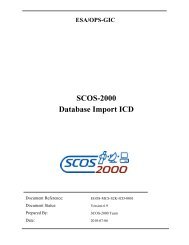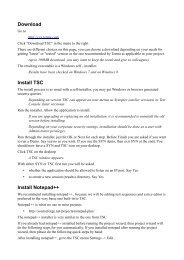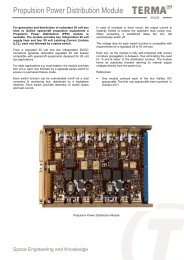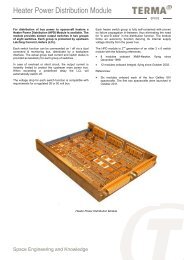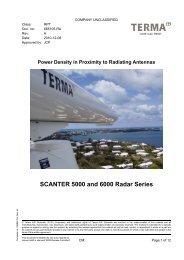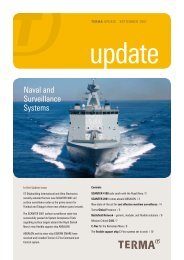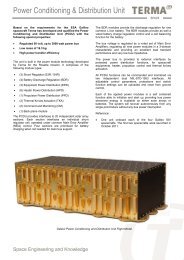Terma A/S Annual Report 2010/11
Terma A/S Annual Report 2010/11
Terma A/S Annual Report 2010/11
Create successful ePaper yourself
Turn your PDF publications into a flip-book with our unique Google optimized e-Paper software.
Accounting Policies<br />
Accounting Policies<br />
The <strong>Annual</strong> <strong>Report</strong> of <strong>Terma</strong> A/S<br />
for <strong>2010</strong>/<strong>11</strong> has been prepared in<br />
accordance with the provisions applying<br />
to class C enterprises (large) under the<br />
Danish Financial Statements Act. The<br />
Consolidated Financial Statements<br />
of <strong>Terma</strong> A/S are consolidated in the<br />
Consolidated Financial Statements of the<br />
ultimate Parent Company, the Thomas B.<br />
Thrige Foundation, Copenhagen.<br />
Accounting policies applied in the<br />
preparation of the <strong>Annual</strong> <strong>Report</strong> are<br />
consistent with those of last year.<br />
Consolidated Financial Statements<br />
The Consolidated Financial Statements<br />
comprise the Parent Company, <strong>Terma</strong><br />
A/S, and subsidiaries in which <strong>Terma</strong> A/S<br />
directly or indirectly holds more than 50<br />
percent of the voting rights or which it,<br />
in some other way, controls.<br />
The Consolidated Financial Statements<br />
are prepared as a consolidation of the<br />
audited financial statements of the Parent<br />
Company and subsidiaries, which have all<br />
been prepared according to the Group’s<br />
accounting policies.<br />
On consolidation, intra-group income<br />
and costs, stockholdings, intra-group<br />
balances and dividends, and realized and<br />
unrealized gains and losses on intra-group<br />
transactions are eliminated.<br />
Equity interests in subsidiaries are set<br />
off against the proportionate share of the<br />
subsidiaries’ fair value of net assets or<br />
liabilities at the acquisition date.<br />
Enterprises acquired or formed during the<br />
year are recognized in the Consolidated<br />
Financial Statements from the date of<br />
acquisition. Enterprises disposed of are<br />
recognized in the Consolidated Statement<br />
of Income until the date of disposal.<br />
18 <strong>Annual</strong> <strong>Report</strong> <strong>2010</strong>/<strong>11</strong><br />
The comparatives are not adjusted for<br />
acquisitions or disposals.<br />
Acquisitions of enterprises are accounted<br />
for using the purchase method, according<br />
to which the identifiable assets and<br />
liabilities acquired are measured at their<br />
fair values at the date of acquisition.<br />
Provisions are made for costs related<br />
to adopted and announced plans to<br />
restructure the acquired enterprise. The<br />
tax effect of the revaluation is taken into<br />
account.<br />
Any excess of the cost of the acquisition<br />
over the fair value of the identifiable<br />
assets and liabilities acquired (goodwill),<br />
including restructuring provisions, is<br />
recognized as intangibles and amortized<br />
on a systematic basis in the Statement of<br />
Income based on an individual assessment<br />
of the useful life of the asset, however,<br />
not exceeding 20 years. Any excess of<br />
the fair values of the identifiable assets<br />
and liabilities acquired over the cost<br />
of the acquisition (negative goodwill),<br />
representing an anticipated adverse<br />
development in the acquired enterprises,<br />
is recognized in the Balance Sheet as<br />
prepayments and deferred charges and<br />
recognized in the Statement of Income<br />
as the adverse development is realized.<br />
Negative goodwill, not related to any<br />
anticipated adverse development, is<br />
recognized in the Balance Sheet at an<br />
amount corresponding to the fair value<br />
of non-monetary assets. The amount is<br />
subsequently recognized in the Statement<br />
of Income over the average useful lives of<br />
the non-monetary assets.<br />
Goodwill and negative goodwill from<br />
acquired enterprises can be adjusted until<br />
the end of the year following the acquisition.<br />
Gains or losses on disposal of subsidiaries<br />
are stated as the difference between the<br />
sales amount or disposal amount and the<br />
carrying value of net assets at the date of<br />
disposal, including non-amortized goodwill<br />
and anticipated disposal costs.<br />
Foreign Currency Translation<br />
Transactions denominated in foreign<br />
currencies are translated at the exchange<br />
rates at the transaction date. Foreign<br />
exchange differences arising between the<br />
exchange rates at the transaction date<br />
and at the date of payment are recognized<br />
in the Statement of Income as financial<br />
income or financial costs.<br />
Receivables, payables, and other<br />
monetary items denominated in foreign<br />
currencies, which are not settled on the<br />
Balance Sheet date, are translated at the<br />
exchange rates at the Balance Sheet date.<br />
The difference between the exchange<br />
rates at the Balance Sheet date and at the<br />
date at which the receivable or payable<br />
arose or was recognized in the latest<br />
financial statements is recognized in the<br />
Statement of Income as financial income<br />
or financial costs.<br />
Upon recognition of subsidiaries that<br />
are foreign entities, the statements of<br />
income are translated at an average<br />
rate of exchange for the month, and the<br />
Balance Sheet items are translated at the<br />
exchange rates at the Balance Sheet date.<br />
Currency translation differences arising<br />
upon translation of foreign subsidiaries’<br />
equity at the beginning of the year to<br />
the exchange rates at the Balance Sheet<br />
date and upon translation of statements<br />
of income from the average rates of<br />
exchange to the exchange rates at the<br />
Balance Sheet date are recognized directly<br />
in the equity.<br />
Translation adjustment of balances with<br />
foreign entities which are considered<br />
part of the aggregate investment in the<br />
subsidiary is recognized directly in the<br />
equity. Correspondingly, foreign exchange<br />
gains or losses on loans and derivative<br />
financial instruments regarded as<br />
currency hedging of foreign subsidiaries<br />
are recognized directly in the equity.<br />
Upon recognition of foreign subsidiaries






